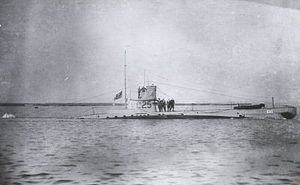HMS C25 was one of 38 C-class submarines built for the Royal Navy in the first decade of the 20th century. The boat survived the First World War and was sold for scrap in 1921.
 HMS C25
| |
| History | |
|---|---|
| Name | HMS C25 |
| Builder | Vickers, Barrow |
| Laid down | 27 February 1908 |
| Launched | 10 March 1909 |
| Commissioned | 28 May 1909 |
| Fate | Sold, 5 December 1921 |
| General characteristics | |
| Class and type | C-class submarine |
| Displacement |
|
| Length | 142 ft 3 in (43.4 m) |
| Beam | 13 ft 7 in (4.1 m) |
| Draught | 11 ft 6 in (3.5 m) |
| Installed power | |
| Propulsion |
|
| Speed |
|
| Range | 910 nmi (1,690 km; 1,050 mi) at 12 kn (22 km/h; 14 mph) on the surface |
| Test depth | 100 feet (30.5 m) |
| Complement | 2 officers and 14 ratings |
| Armament | 2 × 18 in (450 mm) bow torpedo tubes |

Design and description
editThe C-class boats of the 1907–08 and subsequent Naval Programmes were modified to improve their speed, both above and below the surface. The submarine had a length of 142 feet 3 inches (43.4 m) overall, a beam of 13 feet 7 inches (4.1 m) and a mean draft of 11 feet 6 inches (3.5 m). They displaced 290 long tons (290 t) on the surface and 320 long tons (330 t) submerged. The C-class submarines had a crew of two officers and fourteen ratings.[1]
For surface running, the boats were powered by a single 12-cylinder[2] 600-brake-horsepower (447 kW) Vickers petrol engine that drove one propeller shaft. When submerged the propeller was driven by a 300-horsepower (224 kW) electric motor.[1] They could reach 13 knots (24 km/h; 15 mph) on the surface and 8 knots (15 km/h; 9.2 mph) underwater. On the surface, the C class had a range of 910 nautical miles (1,690 km; 1,050 mi) at 12 knots (22 km/h; 14 mph).[3]
The boats were armed with two 18-inch (45 cm) torpedo tubes in the bow. They could carry a pair of reload torpedoes, but generally did not as they would have to remove an equal weight of fuel in compensation.[4]
Career
editC25 was built by Vickers at Barrow and was commissioned on 28 May 1909.
While on patrol 15 miles (24 km) east of Orford Ness on 6 July 1918, C25 was attacked by five German seaplanes returning from a raid on Lowestoft. Attacking out of the sun, C25 was hit by their machine guns before it could use its single Lewis gun in defence. The commanding officer, Lieutenant David Bell and two of the lookouts on the conning tower were killed outright, the fourth man present was mortally wounded. While the seaplanes continued their attack, the crew tried to drag him inside delaying the dive and then one of the bodies slid across the hull, their leg stopping the hatch from being closed. Two more men were killed trying to push the body clear and in desperation the leg was cut off with a hacksaw. By this point German machine gun fire had punctured the hull and damaged the motors. An E-class submarine arrived in the area and drove off the German aircraft with its deck gun and then took C25 under tow.[5] The holes in the pressure hull were plugged by clothes, and HMS E51 was able to tow C25. The seaplanes returned re-armed and ready to attack again, but they were driven off by the arrival of a destroyer HMS Lurcher.[6][7]
HMS C25 was sold on 5 December 1921.
Notes
edit- ^ a b Gardiner & Gray, p. 87
- ^ Harrison, Chapter 25
- ^ Harrison, Chapters 3
- ^ Harrison, Chapter 27
- ^ Grey p243-244.
- ^ "Today in History: 6 July". SeaWaves. Retrieved 1 February 2015.
- ^ "The life and death of William Barge". Devon Heritage. Retrieved 1 February 2015.
References
edit- Akermann, Paul (2002). Encyclopaedia of British Submarines 1901–1955 (reprint of the 1989 ed.). Penzance, Cornwall: Periscope Publishing. ISBN 1-904381-05-7.
- Colledge, J. J.; Warlow, Ben (2006) [1969]. Ships of the Royal Navy: The Complete Record of all Fighting Ships of the Royal Navy (Rev. ed.). London: Chatham Publishing. ISBN 978-1-86176-281-8.
- Gardiner, Robert & Gray, Randal, eds. (1985). Conway's All the World's Fighting Ships 1906–1921. Annapolis, Maryland: Naval Institute Press. ISBN 0-85177-245-5.
- Harrison, A. N. (January 1979). "The Development of HM Submarines From Holland No. 1 (1901) to Porpoise (1930) (BR3043)". RN Subs. Retrieved 27 September 2022.
- Gray, Edwyn (2001). British Submarines in the Great War: A Damned Un-English Weapon. Barnsley, South Yorkshire: Leo Cooper.
- Monograph No. 24: Home Waters—Part II: September and October 1914 (PDF). Naval Staff Monographs (Historical). Vol. XI. The Naval Staff, Training and Staff Duties Division. 1924.